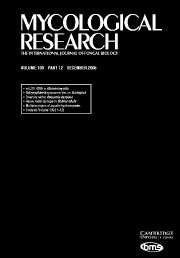Crossref Citations
This article has been cited by the following publications. This list is generated based on data provided by
Crossref.
Esslinger, Theodore L.
2001.
Recent Literature on Lichens—182*.
The Bryologist,
Vol. 104,
Issue. 3,
p.
473.
De Los Ríos, Asunción
Ascaso, Carmen
and
Grube, Martin
2002.
An ultrastructural, anatomical and molecular study of the lichenicolous lichen Rimularia insularis.
Mycological Research,
Vol. 106,
Issue. 8,
p.
946.
Lawrey, James D.
and
Diederich, Paul
2003.
Lichenicolous Fungi: Interactions, Evolution, and Biodiversity.
The Bryologist,
Vol. 106,
Issue. 1,
p.
80.
Simon, Uwe K.
Bauer, Robert
and
Oberwinkler, Franz
2004.
The unique cellular interaction between the leaf pathogen Cymadothea trifolii and Trifolium repens.
Mycologia,
Vol. 96,
Issue. 6,
p.
1209.
Chapman, Russell L.
and
Chapman, Melanie R.
2010.
Symbioses and Stress.
Vol. 17,
Issue. ,
p.
547.
Grube, Martin
Rabensteiner, Johannes
Grube, Ulrike
and
Muggia, Lucia
2010.
Microbial Mats.
Vol. 14,
Issue. ,
p.
341.
Honegger, R.
2012.
Fungal Associations.
p.
287.
Grube, Martin
Köberl, Martina
Lackner, Stefan
Berg, Christian
and
Berg, Gabriele
2012.
Host-parasite interaction and microbiome response: effects of fungal infections on the bacterial community of the Alpine lichenSolorina crocea.
FEMS Microbiology Ecology,
Vol. 82,
Issue. 2,
p.
472.
Ertz, Damien
Diederich, Paul
Lawrey, James D.
Berger, Franz
Freebury, Colin E.
Coppins, Brian
Gardiennet, Alain
and
Hafellner, Josef
2015.
Phylogenetic insights resolve Dacampiaceae (Pleosporales) as polyphyletic: Didymocyrtis (Pleosporales, Phaeosphaeriaceae) with Phoma-like anamorphs resurrected and segregated from Polycoccum (Trypetheliales, Polycoccaceae fam. nov.).
Fungal Diversity,
Vol. 74,
Issue. 1,
p.
53.
Schoch, Conrad
and
Grube, Martin
2015.
Systematics and Evolution.
p.
143.
Pérez-Ortega, Sergio
Garrido-Benavent, Isaac
and
De Los Ríos, Asunción
2015.
Austrostigmidium, a new austral genus of lichenicolous fungi close to rock-inhabiting meristematic fungi inTeratosphaeriaceae.
The Lichenologist,
Vol. 47,
Issue. 3,
p.
143.
Divakar, Pradeep K.
Crespo, Ana
Wedin, Mats
Leavitt, Steven D.
Hawksworth, David L.
Myllys, Leena
McCune, Bruce
Randlane, Tiina
Bjerke, Jarle W.
Ohmura, Yoshihito
Schmitt, Imke
Boluda, Carlos G.
Alors, David
Roca‐Valiente, Beatriz
Del‐Prado, Ruth
Ruibal, Constantino
Buaruang, Kawinnat
Núñez‐Zapata, Jano
Amo de Paz, Guillermo
Rico, Víctor J.
Molina, M. Carmen
Elix, John A.
Esslinger, Theodore L.
Tronstad, Inger Kristin K.
Lindgren, Hanna
Ertz, Damien
Gueidan, Cécile
Saag, Lauri
Mark, Kristiina
Singh, Garima
Dal Grande, Francesco
Parnmen, Sittiporn
Beck, Andreas
Benatti, Michel Navarro
Blanchon, Dan
Candan, Mehmet
Clerc, Philippe
Goward, Trevor
Grube, Martin
Hodkinson, Brendan P.
Hur, Jae‐Seoun
Kantvilas, Gintaras
Kirika, Paul M.
Lendemer, James
Mattsson, Jan‐Eric
Messuti, María Inés
Miadlikowska, Jolanta
Nelsen, Matthew
Ohlson, Jan I.
Pérez‐Ortega, Sergio
Saag, Andres
Sipman, Harrie J. M.
Sohrabi, Mohammad
Thell, Arne
Thor, Göran
Truong, Camille
Yahr, Rebecca
Upreti, Dalip K.
Cubas, Paloma
and
Lumbsch, H. Thorsten
2015.
Evolution of complex symbiotic relationships in a morphologically derived family of lichen‐forming fungi.
New Phytologist,
Vol. 208,
Issue. 4,
p.
1217.
Maier, Stefanie
Muggia, Lucia
Kuske, Cheryl R.
and
Grube, Martin
2016.
Biological Soil Crusts: An Organizing Principle in Drylands.
Vol. 226,
Issue. ,
p.
81.
Edwards, Howell G.M.
Seaward, Mark R.D.
Preece, Tom F.
Jorge-Villar, Susana E.
and
Hawksworth, David L.
2017.
Raman spectroscopic analysis of the effect of the lichenicolous fungus Xanthoriicola physciae on its lichen host.
Symbiosis,
Vol. 71,
Issue. 1,
p.
57.
Diederich, Paul
Lawrey, James D.
and
Ertz, Damien
2018.
The 2018 classification and checklist of lichenicolous fungi, with 2000 non-lichenized, obligately lichenicolous taxa.
The Bryologist,
Vol. 121,
Issue. 3,
p.
340.
Grimm, Maria
Grube, Martin
Schiefelbein, Ulf
Zühlke, Daniela
Bernhardt, Jörg
and
Riedel, Katharina
2021.
The Lichens’ Microbiota, Still a Mystery?.
Frontiers in Microbiology,
Vol. 12,
Issue. ,
Jung, Patrick
Baumann, Karen
Emrich, Dina
Schermer, Michael
Eckhardt, Kai-Uwe
Jandl, Gerald
Leinweber, Peter
Harion, Felix
Wruck, Andreas
Grube, Martin
Büdel, Burkhard
and
Lakatos, Michael
2024.
The dark side of orange: Multiorganismic continuum dynamics within a lichen of the Atacama Desert.
Mycologia,
Vol. 116,
Issue. 1,
p.
44.
Nimis, Pier Luigi
Pittao, Elena
Caramia, Monica
Pitacco, Piero
Martellos, Stefano
and
Muggia, Lucia
2024.
The ecology of lichenicolous lichens: a case-study in Italy.
MycoKeys,
Vol. 105,
Issue. ,
p.
253.

